Structure and Function of X. Tropicalis
The X. tropicalis ( Western clawed frog) inhabits the tropical and subtropical rainforests of Africa. It is a medium-sized frog with eyes positioned high on the head, have short limbs, and “fully webbed feet with horny like claws” (Tropical Fish Keeping). It is the only species in the Xenopus genus that has diploid.
As part of the Pipidae family of frogs, X. Tropical exhibits lack of tongue and visible ear. The males also lack vocal cords but are able to lure females due to a “rapid muscle contraction in the throat” that produces clicking noise (Smithsonian’s National Zoo). The front limbs are small with non-webbed fingers and are utilized to aid them to push their food into the mouth. Their hind legs are large and webbed, and there clawed like feet are used to “tear apart larger pieces of food” (Smithsonian’s National Zoo). The gut “select for rare external microbiota and the abundance of gut microbiota can be influenced by ambient temperature” (Li). X. tropicalis also have transparent eyelids to help them protect their eyes, see underwater, and hide from predators.
X. Tropicalis has approximately “1.7 GBP on 10 chromosomes,” and two copies of every chromosome compared to African clawed frogs, which has four copies (Hellsten 633). It has a short generation time of 6 months and can produce many offspring. This makes X. tropicalis “multigeneration screening and genetic analysis strategies feasible” (Showell and Conlon). During the rainy season, they migrate to the forests in search of spawning sites because they are vulnerable to climate change. This is significant because their permeable skin limits dispersal capacity and threatens the “reproduction and development” of the offspring (Herrel et al.) They also have specific Transient Receptor Potential (TRP) channels called TRPV3 on the plasma membrane. This is significant to the X. tropicalis because it serves “as a sensor to detect noxious cold temperature” (Saito, Shigeru, et al. 9). This helps X. tropicalis adjust to the temperature during harsh climate and especially during the spawning season.
In an experiment conducted by Showell and Conlon to test “the routine generation and successful husbandry of tadpoles,” they induced natural mating in the Western clawed frog by injecting them with a hormone (Showell and Conlon). They concluded that natural mating produces more offsprings than Vitro fertilization. This is an advantage for genetic screens as it “does not involve sacrificing male frogs to obtain testes or spermatozoa” (Showell and Conlon). Another factor is that Xenopus embryos develop outside the body, and it makes it easier to “surgically manipulated or treated with proteins and chemicals that interfere with development” (“Why Use the Frog in Research?”). However, X. tropicalis is sensitive to crossbreeding. The crossbreeds of a male X. laevis and a female X. tropicalis, the embryos are unable to “fully recognize the paternal chromosomes” (Radboud University Nijmegen). Therefore the offspring’s cells have incomplete genes and are unable to survive. On the other hand, embryos are viable when a female X. laevis is crossbred with a male X. tropicalis.
Works Cited
“African Clawed Frog.” Smithsonian’s National Zoo, 12 June 2018, nationalzoo.si.edu/animals/african-clawed-frog.
Hellsten, Uffe, et al. “The Genome of the Western Clawed Frog. Science, vol. 328, no. 5978, 2010, pp. 633–636. JSTOR, www.jstor.org/stable/40655841.
Herrel, Anthony, and Camille Bonneaud. “Temperature Dependence of Locomotor Performance in the Tropical Clawed Frog, Xenopus Tropicalis.” Journal of Experimental Biology, The Company of Biologists Ltd, 15 July 2012, jeb.biologists.org/content/215/14/2465.
Li, Jiaying, et al. “Ambient Temperature Alters Body Size and Gut Microbiota of Xenopus Tropicalis.” Science China. Life Sciences, Oct. 2019. EBSCOhost, doi:10.1007/s11427-019-9540-y.
Radboud University Nijmegen. “Frogs Reveal Mechanism That Determines Viability of Hybrids.” Phys.org, Phys.org, 11 Jan. 2018, https://phys.org/news/2018-01-frogs-reveal-mechanism-viability-hybrids.html
Saito, Shigeru, et al. “Evolution of Vertebrate Transient Receptor Potential Vanilloid 3 Channels: Opposite Temperature Sensitivity between Mammals and Western Clawed Frogs.” PLoS Genetics, vol. 7, no. 4, Apr. 2011, pp. 1–11. EBSCOhost, doi:10.1371/journal.pgen.1002041.
Showell, Chris, and Frank L Conlon. “Natural mating and tadpole husbandry in the western clawed frog Xenopus tropicalis.” Cold Spring Harbor protocols vol. 2009,9 (2009): pdb.prot5292. doi:10.1101/pdb.prot5292
Showell, Chris, and Frank L. Conlon. “The Western Clawed Frog (Xenopus Tropicalis): An Emerging Vertebrate Model for Developmental Genetics and Environmental Toxicology.” Cold Spring Harbor Protocols, vol. 2009, no. 9, Sept. 2009, p. pdb.emo131. EBSCOhost, doi:10.1101/pdb.emo131.
“Western Clawed Frog (Xenopus Tropicalis).” Tropical Fish Keeping, 23 Nov. 2016, www.tropical-fish-keeping.com/western-clawed-frog-xenopus-tropicalis.html#sthash.2cK2mUrr.dpbs.
“Why Use the Frog in Research?” Facts, The Public Engagement Team at the Wellcome Genome Campus, 12 Feb. 2015, www.yourgenome.org/facts/why-use-the-frog-in-research.

